Tharu people
 Tharu woman | |
| Regions with significant populations | |
|---|---|
| 1,737,470[1] | |
| Bihar | 159,939[2] |
| Uttar Pradesh | 105,291 |
| Uttarkhand | 91,342 |
| Languages | |
| Tharu languages, Nepali language | |
| Religion | |
| Hinduism, Buddhism, traditional beliefs | |
| Related ethnic groups | |
The Tharu people are an ethnic group indigenous to the southern foothills of the Himalayas; most of the Tharu people live in the Nepal Terai.[3][4][5][6] The word थारू thāru[7] is thought to be derived from sthavir meaning follower of Theravada buddhism.[8]Some Tharu groups also live in the Indian Terai, foremost in Uttarakhand, Uttar Pradesh and Bihar.[9][10][11]
The Tharus are recognized as an official nationality by the Government of Nepal.[12] The Government of India recognizes the Tharu people as a scheduled tribe.[9]
History
The origin of the Tharu people is not clear but surrounded by myths and oral tradition. The Rana Tharus claim to be of Rajput origin and have migrated from the Thar Desert to Nepal's Far Western Terai region. Tharu people farther east claim to be descendants of the Śākya and Koliya peoples living in Kapilvastu.[8]
Modern history (1700s-1999)
Tharu families worked under the system of bonded labour known as Kamaiya which existed in Nepal since the 18th century; following the Unification of Nepal when members of the ruling elite families of Terai received land grants in those region and were entitled to collect revenue from those who cultivated the land.[13] In 1854, Jung Bahadur Rana, the then Nepalese PM, enforced the Muluki Ain (General Code) which classified both Hindus and Non-Hindus castes based on their habits of food and drink.[14] Tharu people were categorized under "Paani Chalne Masinya Matwali" (touchable enslavable alcohol drinking group) together with several other alcohol drinking ethnic minorities.[15][16]
In the late 1950s, the World Health Organisation supported the Nepalese government in eradicating malaria in the forests of the central Terai.[17] Following the malaria eradication program using DDT in the 1960s, a large and heterogeneous non-Tharu population from the Nepali hills, Bhutan, Sikkim and India settled in the region.[18] In the western Terai, many Tharu families lost the land, which they used to cultivate, to these immigrants and were forced as Kamaiya.[6]
When the first protected areas were established in Chitwan, Tharu communities were forced to relocate from their traditional lands. They were denied any right to own land and thus forced into a situation of landlessness and poverty. When the Chitwan National Park was designated, Nepalese soldiers destroyed the villages located inside the boundary of the park, burned down houses, and beat the people who tried to plough their fields. Some threatened Tharu people at gun point to leave.[5]
Recent history (2000-present)
The Government of Nepal outlawed the practice of bonded labour prevalent under the Kamaiya system in July 2000, which prohibits anyone from employing any person as a bonded labourer, and declared that the act of making one work as a bonded labourer is illegal.[19] Though democracy has been reinstated in the country, the Tharu community has called for a more inclusive democracy as they are fearful of remaining an underprivileged group.[20]
Distribution
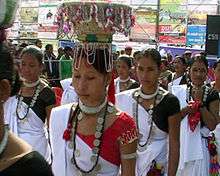
As of 2011, the Tharu population of Nepal was censused at 1,737,470 people, or 6.6% of the total population.[1] In 2009, the majority of Tharu people were estimated to live in Nepal.[21] There are several endogamous sub-groups of Tharu that are scattered over most of the Terai:[22][5]
- Rana Tharu in the Kailali and Kanchanpur districts of the far western Nepal Terai; also in India, in Udham Singh Nagar district, Uttarakhand and Kheri Terai, Uttar Pradesh. Rana Tharu claim Rajput origin.[23]
- Kathoriya Tharu mostly in Kailali District and in India[24]
- Sonha Tharu in Surkhet district[25]
- Dangaura Tharu in western Terai: Dang-Deukhuri, Banke, Bardia, Kailali and Kanchanpur districts[26]
- Paschuhan (Western) Tharu in Rupandehi and Nawalparasi districts
- Rautar Tharu in Rupandehi and Nawalparasi districts
- Purbaha Tharu in Rupandehi and Kapilvastu districts
- Aarkutwa or Chitwania Tharu in central Terai: Sindhuli, Chitwan and Nawalparasi districts[12]
- Kochila Tharu in eastern Terai: Saptari, Bara, Parsa, Rautahat, Sarlahi, Mahottari and Udayapur districts[27]
- Danuwar in eastern Terai: Udayapur, Saptari and Morang districts.[28]
- Lampucchwa Tharu in Morang District
- Pahalman Tharu, especially in Inner Terai such as Udayapur district of Nepal
Smaller numbers of Tharu people reside in the adjacent Indian districts Champaran of Bihar state; Gorakhpur, Basti and Gonda of Uttar Pradesh state; and Udham Singh Nagar, Uttarakhand state.[4] In 2001, Tharu people were the largest of five scheduled tribes in Uttarakhand, with a population of 256,129 accounting for 33.4% of all scheduled tribes.[29] In the same year, they constituted 77.4% of the total tribal population of Uttar Pradesh with a population of 83,544.[30]
Culture
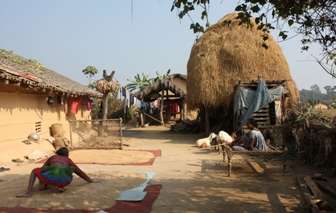

The Tharu people themselves say that they are a people of the forest. In Chitwan, they have lived in the forests for hundreds of years practicing a short fallow shifting cultivation. They plant rice, mustard, corn and lentils, but also collect forest products such as wild fruits, vegetables, medicinal plants and materials to build their houses; hunt deer, rabbit and wild boar, and go fishing in the rivers and oxbow lakes.[5]
The Tharus never went abroad for employment – a life that kept them isolated in their own localities.[31] In this isolation they developed a unique culture free from the influence of adjacent India, or from the mountain groups of Nepal. The most striking aspects of their environment are the decorated rice containers, colorfully painted verandahs and outer walls of their homes using only available materials like clay, mud, dung and grass. Much of the rich design is rooted in devotional activities and passed on from one generation to the next, occasionally introducing contemporary elements such as a bus or an airplane.[32] The Deukheri Tharu are known for their colorful, shell and/or feather decorated basketry, including ram topne water jug covers.
Household structure
In the western Terai, most Rana Tharu prefer living in Badaghar called longhouses with big families of many generations, sometimes 40-50 people. All household members pool their labor force, contribute their income, share the expenditure and use one kitchen.[33]
Social structure
Tharus from the mid west and far west of Nepal have been practicing the Badghar system, where a Badghar is elected chief of a village or a small group of villages for a year. The election generally takes place in the month of Magh (January / February), after celebrating the Maghi Festival and after completing major farming activities. In most cases, each household in the village which engages in farming has one voting right for electing a Badghar. Thus the election is based on a count of households count rather than a headcount. The role of the Badghar is to work for the welfare of the village. The Badghar direct the villagers to repair canals or streets when needed. They also oversee and manages the cultural traditions of the villages. They have an authority of punishing those who do not follow their orders or who go against the welfare of the village. Generally the Badghar has a Chaukidar to help him. With the consent of the villagers the Badghar may appoint a"Guruwa" who is the medic and chief priest of the village.
As Tharus society is mainly involved in farming, irrigation is one of the most important aspects of the community. Tharus in western Nepal built canals that irrigate thousands of hectares of land. Hundreds of years ago, without using any sophisticated tools, they built hundreds of kilometers of irrigation canals in the Kailali and Bardiya districts of Nepal. An irrigation canal could be used by several villages. Its water and diversion works need to be managed fairly. For this purpose, the Badghars of different villages elect a person for the position of Chaudhary to manage a canal system. When needed, the Chaudhary orders the Badghars to send people to repair or build the canals. In most cases the Badghars and Chaudharis are unpaid leaders of the community. However, they are exempt from compulsory physical labor for the betterment of the society. As a token of respect, the community members may also help them in farming for a day free of cost.
Language
Tharu communities in different parts of Nepal and India do not share the same language. Several speak various endemic Tharu languages. In western Nepal and adjacent parts of India, Tharus speak variants of Hindi, Urdu and Awadhi. In and near central Nepal, they speak a variant of Bhojpuri. In eastern Nepal, they speak a variant of Maithili. More standard versions of these dialects are widely spoken by non-Tharu neighbors in the same areas so that there are no important linguistic barriers between Tharus and their neighbors. However, there are linguistic barriers between these dialects standing in the way of communication between Tharus from different regions.[6] They also speak Nepali language.
Tharus already lived in the Terai before Indo-Europeans arrived. It is unclear which language they have been speaking at that time. The only surviving pre-Indo-European language in the Terai is Kusunda, Santhali further west.
Cuisine
Tharu people of Nepal have different and special food items like Bagiya[34][35] or Dhikri and ghonghi, an edible snail collected in nearby water bodies. Dhikri is made of rice flour. The dough from the rice flour is given different shapes – many are stick-like but some are also given the shapes of birds, fish and animals. It is cooked over steam and eaten together with chutney or curry. The ghonghi are left overnight so that all the gooey material inside them comes out. Their tail end is cut so that it is easier to suck out the meat from the shell. They are boiled and later cooked like curry adding spices like coriander, chilies, garlic and onions.
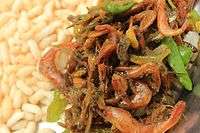 Dried fish dish; Tharu Cuisine
Dried fish dish; Tharu Cuisine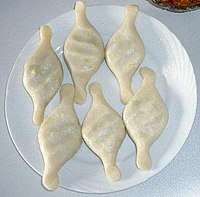 Bagya; Tharu Cuisine
Bagya; Tharu Cuisine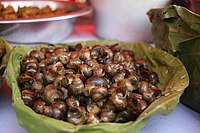 Ghunghi; Tharu Cuisine
Ghunghi; Tharu Cuisine Rice Wine; Tharu Cuisine
Rice Wine; Tharu Cuisine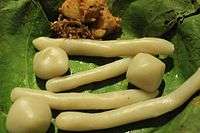 Dhikari; Tharu Cuisine
Dhikari; Tharu Cuisine Boiled Corn with chili pickle
Boiled Corn with chili pickle
Tharu people of India are also known for their spicy and distinct food. Dhissaphara is similar to Dhikri.
Marriage system
Traditionally, marriages were often arranged during the pregnancies of two women. If they gave birth to opposite sex babies, the two babies were supposed to be married if they grew up as friends. It was problematic if a boy or girl came of age and rejected their assigned fiancé(e). Finding a replacement was difficult because most girls and boys were already engaged. However this custom has been disappearing. Most Tharus now practice conventional arranged marriages. They also practice love marriages, inter caste marriage, marriage after courtship and eloping.
Religion
The spiritual beliefs and moral values of the Tharu people are closely linked to the natural environment. The pantheon of their gods comprises a large number of deities that live in the forest. They are asked for support before entering the forest.[5]
Genetics
Genetic studies on Y-DNA of Tharu populations from two villages in Chitwan district and one village in Morang district found very high presence of Haplogroup O at 37% followed by H (26%), J (14%), R1a (9%), R2 (5%), L (2%) and C(1%).[36]
Resistance to malaria
The Tharu were famous for their ability to survive in the most malarial parts of the Terai that were deadly to outsiders. In 1902, a British observer noted: "Plainsmen and paharis generally die if they sleep in the Terai before November 1 or after June 1." Others thought that the Tharu were not totally immune.[6]
Contemporary medical research comparing Tharu with other ethnic groups living nearby found an incidence of malaria nearly seven times lower among Tharu.[37] The researchers believed such a large difference pointed to genetic factors rather than behavioral or dietary differences. This was confirmed by follow-up investigation finding genes for thalassemia in nearly all Tharu studied.[38]
See also
References
- 1 2 Central Bureau of Statistics (2012). National Population and Housing Census 2011 (National Report) (PDF). Government of Nepal, National Planning Commission Secretariat, Kathmandu. Archived from the original (PDF) on April 18, 2013.
- ↑ ORGI. "A-11 Individual Scheduled Tribe Primary Census Abstract Data and its Appendix". www.censusindia.gov.in. Office of the Registrar General & Census Commissioner,India. Retrieved 2017-11-20.
- ↑ Bista, D. B. (1971). People of Nepal (second ed.). Kathmandu: Ratna Pustak Bhandar.
- 1 2 Rajaure, D. P. (1981). "Tharus of Dang: the people and the social context" (PDF). Kailash. Kathmandu: Ratna Pustak Bhandar. 8 (3/4): 155–185.
- 1 2 3 4 5 McLean, J. (1999). "Conservation and the impact of relocation on the Tharus of Chitwan, Nepal". XIX (2). Himalayan Research Bulletin: 38–44.
- 1 2 3 4 Guneratne, A. (2002). Many tongues, one people: The making of Tharu identity in Nepal. Ithaca, New York: Cornell University Press.
- ↑ Turner, R. L. (1931). "थारु thāru". A Comparative and Etymological Dictionary of the Nepali Language. London: K. Paul, Trench, Trubner.
- 1 2 Skar, H. O. (1995). Myths of origin: the Janajati Movement, local traditions, nationalism and identities in Nepal. Contributions to Nepalese Studies 22 (1): 31–42.
- 1 2 Verma, S.C. (2010). "The eco-friendly Tharu tribe: A study in socio-cultural dynamics" (PDF). Journal of Asia Pacific Studies. 1 (2): 177–187.
- ↑ "Genes and Resistance to Disease". p. 110. Retrieved 31 March 2017.
- ↑ "Internal Conflicts: Military Perspectives". p. 62. Retrieved 31 March 2017.
- 1 2 Lewis, M. P., G. F. Simons, and C. D. Fennig (eds.) (2014). "Tharu, Chitwania: a language of Nepal". Ethnologue: Languages of the World, Seventeenth edition. Dallas, Texas: SIL International, online version.
- ↑ Regmi, R. R. (1994). "Deforestation and Rural Society in the Nepalese Terai" (PDF). Occasional Papers in Sociology and Anthropology. 4: 72–89.
- ↑ Stiller, L. F. (1993). Nepal: Growth of a Nation. Human Resources Development Research Center, Kathmandu.
- ↑ Gurung, H. (2005). Social exclusion and Maoist insurgency. Paper presented at National Dialogue Conference on ILO Convention 169 on Indigenous and Tribal Peoples, Kathmandu, 19–20 January 2005.
- ↑ Krauskopff, G. (2007). "An 'indigenous minority' in a border area: Tharu ethnic associations, NGOs, and the Nepalese state". In Gellner, D. Resistance and the State: Nepalese Experiences (Revised ed.). New York: Berghahn Books. pp. 199–243.
- ↑ Brydon, H.W., Joshi, G. and Pradhan, S.P. (1961). "Anopheles distribution and its relation to the malaria eradication programme in central Nepal" (PDF). Mosquito News 21 (2): 102–105.
- ↑ Terrenato, L., Shrestha, S., Dixit, K.A., Luzzatto, L., Modiano, G., Morpurgo, G., Arese, P. (1988). "Decreased malaria morbidity in the Tharu and Maithil people compared to sympatric populations in Nepal". Annals of Tropical Medicine and Parasitology. 82 (1): 1–11. PMID 3041928.
- ↑ Sapkota, M. (2014). "Contested Identity Politics in Nepal: Implications from Tharu Movement" (PDF). IOSR Journal of Humanities and Social Science. 19 (7): 16–25.
- ↑ Gorkhapatra Sansthan (2007). "Tharu community calls for inclusive democracy". The Rising Nepal. Archived from the original on 2007-09-28.
- ↑ Central Bureau of Statistics (2009). "Chapter 1: Area and Population; Table 1.7: Population Distribution by Caste/Ethnic Groups and Sex for Nepal, 2001". Statistical Year Book of Nepal 2009. Kathmandu: Government of Nepal.
- ↑ Krauskopff, G. (1995). "The anthropology of the Tharus: an annoted bibliography" (PDF). Kailash. 17 (3/4): 185–213.
- ↑ Lewis, M. P., G. F. Simons, and C. D. Fennig (eds.) (2014). "Tharu, Rana: a language of Nepal". Ethnologue: Languages of the World, Seventeenth edition. Dallas, Texas: SIL International. Online version.
- ↑ Lewis, M. P., G. F. Simons, and C. D. Fennig (eds.) (2014). "Tharu, Kathoriya: a language of Nepal". Ethnologue: Languages of the World, Seventeenth edition.
- ↑ Lewis, M. P., G. F. Simons, and C. D. Fennig (eds.) (2014). "Sonha, a language of Nepal". Ethnologue: Languages of the World, Seventeenth edition. Dallas, Texas: SIL International. Online version.
- ↑ Lewis, M. P., G. F. Simons, and C. D. Fennig (eds.) (2014). "Tharu, Dangaura: a language of Nepal". Ethnologue: Languages of the World, Seventeenth edition. Dallas, Texas: SIL International. Online version.
- ↑ Lewis, M. P., G. F. Simons, and C. D. Fennig (eds.) (2014). "Tharu, Kochila: a language of Nepal". Ethnologue: Languages of the World, Seventeenth edition. Dallas, Texas: SIL International. Online version.
- ↑ Lewis, M. P., G. F. Simons, and C. D. Fennig (eds.) (2014). "Dhanwar: a language of Nepal". Ethnologue: Languages of the World, Seventeenth edition. Dallas, Texas: SIL International. Online version.
- ↑ Office of the Registrar General, India (2001). "Uttaranchal. Data Highlights: The Scheduled Tribes. Census of India 2001" (PDF). Retrieved 2008-03-16.
- ↑ Office of the Registrar General, India (2001). "Uttar Pradesh. Data Highlights: The Scheduled Tribes. Census of India 2001" (PDF).
- ↑ Gurung, G.M. (1992). "Socioeconomic Network of a Terai Village: An account of the Rana Tharus of Urma-Urmi" (PDF). Contributions to Nepalese Studies, Vol. 19, No. 1.
- ↑ Meyer, K. W., Deuel, P. (1997). "The Tharu of the Tarai". Indigo Gallery, Kathmandu. Retrieved 2006-12-07.
- ↑ Lam, L. M. (2009). "Park, hill migration and changes in household livelihood systems of Rana Tharus in Far-western Nepal" (PDF). University of Adelaide. Archived from the original (PDF) on September 28, 2011.
- ↑ Chaudhary, Sanjib (2012-12-14). "VOICE OF THARUS: Bagiya – the rice flour dumplings made the Tharu way". VOICE OF THARUS. Retrieved 2018-09-15.
- ↑ "Tharu Cuisines and Delicacies (in Pictures) - The Nepali Food Blog | theGundruk.com". The Nepali Food Blog | theGundruk.com. 2016-01-16. Retrieved 2018-09-15.
- ↑ Fornarino S, Pala M, Battaglia V; et al. (2009). "Mitochondrial and Y-chromosome diversity of the Tharus (Nepal): a reservoir of genetic variation". BMC Evol. Biol. 9: 154. doi:10.1186/1471-2148-9-154. PMC 2720951. PMID 19573232.
- ↑ Terrenato, L.; Shrestha, S.; Dixit, K. A.; Luzzatto, L.; Modiano, G.; Morpurgo, G.; Arese, P. (1988). "Decreased Malaria Morbidity in the Tharu People Compared to Sympatric Populations in Nepal". Annals of Tropical Medicine and Parasitology. 82 (1): 1–11. PMID 3041928.
- ↑ Modiano, G., Morpurgo, G., Terrenato, L., Novelletto, A., Di Rienzo, A., Colombo, B., Purpura, M., Marianit, M., Santachiara-Benerecetti, S., Brega, A., Dixit, K. A., Shrestha, S. L., Lania, A., Wanachiwanawin, W. and L. Luzzatto (1991). "Protection against Malaria Morbidity - Near Fixation of the Alpha Thalassemia Gene in a Nepalese Population" (PDF). American Journal of Human Genetics. 48 (2): 390–397. PMC 1683029. PMID 1990845.
Further reading
- Ashokakirti, Bhikshu. "Searching the Origin of Selfless Self". Journal of Nepalese Studies. Kathmandu: Royal Nepal Academy. 3 (1).
- Bista, Dor Bahadur (2004). People of Nepal (9th ed.). Kathmandu: Ratna Pustak Bhandar.
- Krauskopff, G. (1989). Maîtres et possédés: Les rites et l'ordre social chez les Tharu (Népal) (in French). Paris: Editions du Centre National de la Recherche Scientifique.
- Meyer, K.; Deuel, P., eds. (1998). The Tharu Barka Naach: a rural folk art version of the Mahabharata. Lalitpur: Himal Books. ISBN 0-9666742-0-0.
External links
| Wikimedia Commons has media related to Tharu people. |